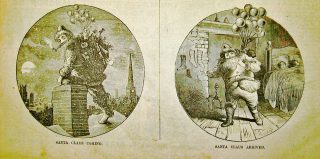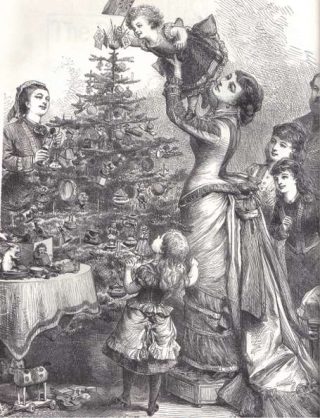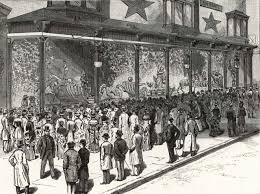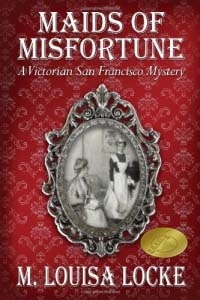By M. Louisa Locke-Award Winning Author
Because the most recent book in my Victorian San Francisco Mystery series, Pilfered Promises, is set during the period between Thanksgiving and Christmas, 1880, I spent a good deal of time researching how residents of that city were celebrating the holidays that year, including looking for articles in the San Francisco Chronicle. What I found was that many of the traditions that we are familiar with today started in the Nineteenth century…including the importance of advertising special holiday sales!
“The Arcade: We are offering this week SPECIAL and EXTRAORDINARY INDUCEMENTS to buyers of HOLIDAY PRESENTS, especially in our SILK DEPARTMENT” ––San Francisco Chronicle, December 19, 1880
However, these traditions were actually relatively new. Before the mid-1880s, most native-born Americans, particularly Protestants from the Northeast, saw Thanksgiving and not Christmas as the key national holiday. In fact, throughout the 1800s, a number of Protestant denominations were very resistant to the celebration of the birth of Christ in any fashion beyond religious observances.
Not surprisingly, it was the Southern state of Louisiana, where there was a significant Catholic population, that first declared December 25th a holiday (in 1837), and Christmas wasn’t declared a national legal holiday until 1875. The huge influx of European immigrants to the United States, starting in the 1840s, many from Catholic countries, also played an important role in shaping the way Christmas began to be celebrated, especially in the larger cities.
This multi-cultural perspective certainly held true for San Francisco in 1880, which makes sense since at that date three-quarters of the city’s population of over 233,000 were immigrants or their native-born children.
The Stocking:
“But the presents would lose half their charm did they not come through the medium of the huge stocking, religiously pinned to the chimney side…” ––San Francisco Chronicle, December 25, 1880
On Christmas day, the San Francisco Chronicle detailed some of the different ways that the holiday had been observed around the city, mentioning that one of the key traditions practiced by native-born San Franciscans was hanging stockings on Christmas eve.
An article on the history of Christmas traditions suggests that the descendants of New England Puritans, many who still were uncomfortable with anything that smacked of a secular celebration of Christ’s birth, were particularly enthusiastic about this stocking tradition because it shifted the main celebration to Christmas Eve.
Hence, the enormous popularity of the now famous poem, T’was the Night Before Christmas, which was first published in 1823. By 1880, for many Americans, the key elements of this poem…the stockings hung on the fireplace, the severe Saint Nicholas transformed into Santa Claus––a jolly old elf with his sleigh and reindeer––and the emphasis on presents for children, had become the personification of Christmas.
As an interesting side-note, one source suggests that it was the Irish (the largest immigrant group in San Francisco in 1880) who introduced the American tradition of leaving out milk and cookies for Santa Claus. Evidently this was based on their homeland tradition of the “laden table” where on Christmas Eve the door was left open for Mary and Joseph to enter and find milk and a loaf of sweet bread to eat on their journey.
The Tree:
“Christmas eve, and the parted curtains of many a gayly-lighted San Francisco home revealed a fancifully decked Christmas tree and happy faces of children as they viewed the gifts it bore for them.”––San Francisco Chronicle, December 25, 1880
Germans are generally credited with the use of a decorated fir tree as an important part of Christmas celebrations, a tradition they introduced in England and the United States. For England, it was the marriage of Prince Albert to Queen Victoria (and the introduction of a tree at Windsor Castle by 1841) made this a popular Victorian custom in England.
However, in America, it was the successive waves of German immigrants (Germans were the second largest group of immigrants in San Francisco in 1880) that made the evergreen tree a central part of the American Christmas tradition. Germany was also the source of many of the ideas about what should be used to decorate the tree, and their tradition of filling the tree with candles (which makes me shudder over the fire hazard) and tying small gifts and bags of candied sweets on to the branches had become fairly universal in America by 1880. The hand-made silver wire and glass ornaments found in wealthier homes were often German imports, although by 1880, Woolworth sold inexpensive commercially produced ornaments as well.
I was delighted to discover that tinsel was another 19th century German tradition that was imported to America. Made first of silver, by the 1800s tinsel was mixed with other metals like lead and mass produced, which was supposed to cut back on how easily it tarnished. I had my protagonist, Annie, decide not to use tinsel on her tree to honor my late father, who hated the stuff! But they did string popcorn, which, along with cranberries, was an American addition to the German tradition of stringing other edibles like nuts, dates, and gingerbread cookies on the tree.
Other Traditions:
According to the San Francisco Chronicle, the English (third largest immigrant group in San Francisco in 1880) were the source of many of the games played in middle-class parlors. And supposedly it was the English residents in San Francisco who complained when they couldn’t find mistletoe to hang in doorways. The idea of kissing under mistletoe was initially a tradition among the English servant classes, but it was popularized, as many Victorian Christmas traditions were, in the mid 19th century fiction of Charles Dickens.
The singing of carols seem to have multiple origins and been around for more centuries, for example, Angels We Have Heard on High was composed in 13th century. However, a good number of classic carols like It Came Upon A Midnight Clear, We Three Kings of Orient Are, and O Little Town of Bethlehem, were composed in the United States in the mid 19th century.
The Department Store Windows
By 1875, Macy’s Company had started what would be come a widespread tradition of decorating its store windows with a series of tableaux for Christmas. (I certainly remember the yearly trip to “downtown” Pittsburgh, Pennsylvania in the 1950s to see the Gimbels’ and Horne’s Christmas store windows.) Since the mystery in Pilfered Promises is set in a fictional department store modeled on Macy’s (called the Silver Strike Bazaar), I decided to give this store a splendid window display. Here is a short section from the novel where Kathleen Hennessey, an Irish maid, gets her first glimpse of the Silver Strike windows, all decorated for the holidays.
Miss Blaine’s coachman had dropped them off right in front of the Silver Strike Bazaar. Made Kathleen feel like royalty. This gave them three hours to shop before going to lunch at the Silver Strike restaurant at eleven. Then the coachman would be back to pick the three of them up and bring them back to the boarding house. She would get back to work and Miss Dawson and Miss Blaine would meet Seth Timmons and Mr. Nate’s friend, Mitchell. The four of them were going down the peninsula to the San Bruno Mountains to cut down a tree. She’d never been in a house before that brought in a real tree for the holidays.
Mrs. O’Rourke said that Mrs. Dawson’s aunt and uncle always had a large fir tree in the parlor and she was glad that the mistress was starting that tradition up again. Although she said it was a nuisance to keep everyone from tracking needles all through the house.
The window in front of her looked like a tiny parlor itself, with a small tree covered all over with red bows, strings of tiny brightly colored balls, and silver strips that Miss Kitty called tinsel. Kathleen got goosebumps picturing what their own parlor would look like by the end of this evening.
Miss Dawson, walking from one window to the next, told Kathleen how each scene was from a famous story about Santa Claus and a carriage pulled by reindeer.”––Pilfered Promises
*******
Wishing you all a very Happy Holidays as you celebrate your own traditions.
- Louisa Locke, a retired professor of U.S. and Women’s History, has a successful second career as the author of the best-selling Victorian San Francisco Mystery series. Pilfered Promises, a sweet cozy historical mystery, is the fifth novel in this series featuring Annie and Nate Dawson and their friends and family in the O’Farrell Street boarding house. The first two books in this series, Maids of Misfortune (an IndieBrag honoree) and Uneasy Spirits are currently free and information on where to buy these books and others in the series can be found at HERE
Sources:
“Christmas Customs: How Various Nationalities Observe the Day in Our City,”
San Francisco Chronicle; Dec 25, 1880
“German Community Popularized Christmas Tree Tradition,” Bill Kemp, McClean County Museum of History
“Christmas Tradition: The Christmas Tree Custom,” Pauline Weston Thomas for Fashion Era.com
“Irish American Christmas,” Florida Irish Heritage Center
“The Origin of American Christmas Myth and Customs,” B. K. Swartz, Jr.




I really enjoy reading this book Pilfered Promises. It reminds me a lot of my own childhood. All those Christmas traditions described in this article were celebrated in Europe in 1950s and 1960s when I was a child. We also were used to have the candles on the Christmas tree branches but surprisingly, there was never a fire in our house or anybody else’s I knew. The candles were replaced by the electrical lights about in late 1960s. We did not put any edible items on a tree except wrapped chocolate candies. The tree was usually not decorated until morning on Christmas Eve and Christmas Eve was a major Christmas celebration with gift giving and big supper. Not much was done on Christmas Day. We did not have Santa Claus…..we had Jesus Christ who distributed the Christmas presents. This tradition is still held in many European countries. Also stores were displaying their goods not before December 6 and Christmas tree was usually up until January 6 (Three Kings day).